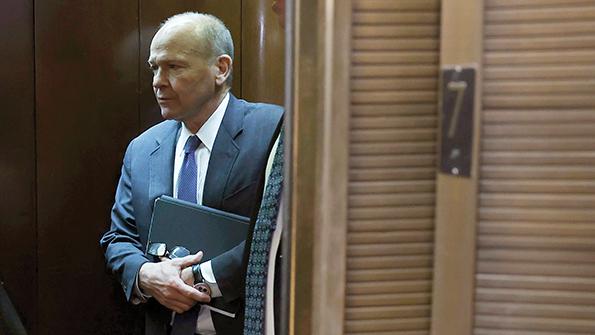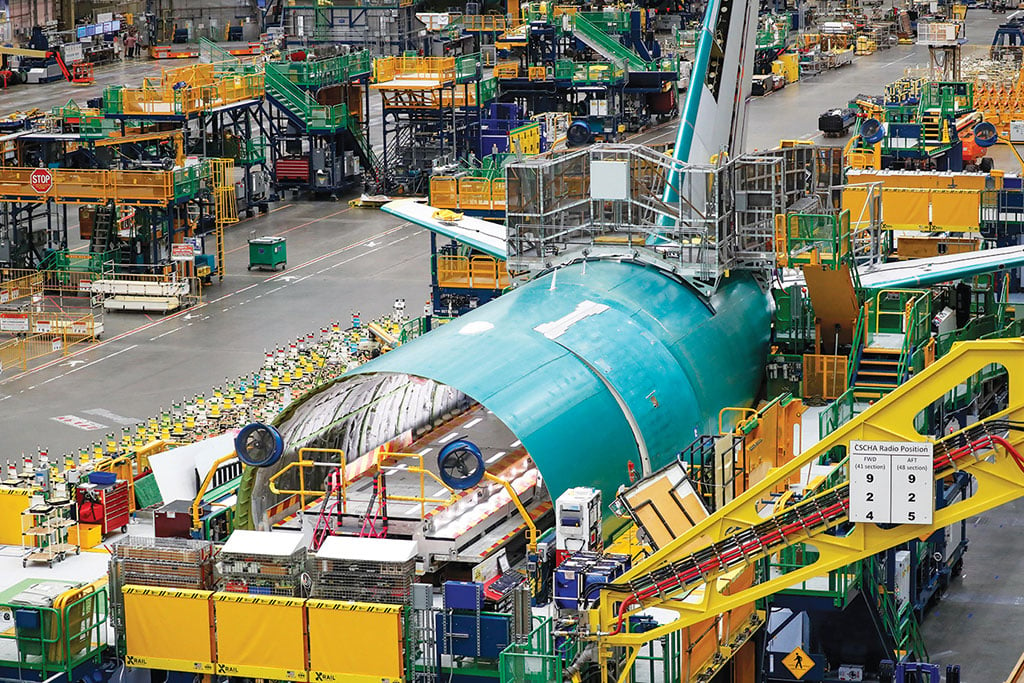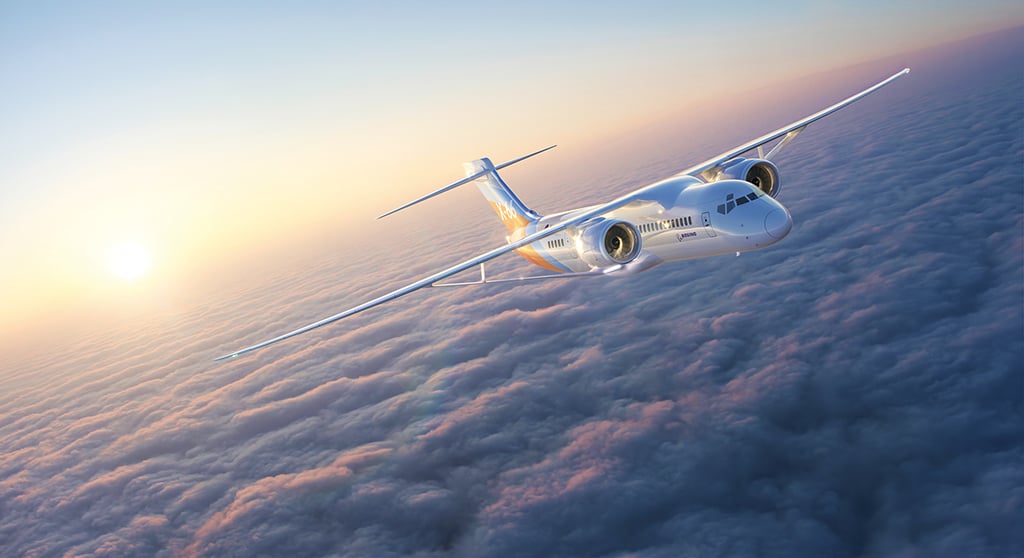This article is published in Aviation Week & Space Technology and is free to read until May 04, 2024. If you want to read more articles from this publication, please click the link to subscribe.
The Quarter When Boeing Broke

The search for David Calhoun’s successor as Boeing’s top executive is underway earlier than planned.
This was not part of the plan. When David Calhoun cemented his long-term position as Boeing CEO in April 2021 at age 64, the board of directors raised the corporate retirement age cap for the CEO to 70 from 65. The company also announced the departure of Chief Financial Officer Greg Smith after a decade in the job. The changes ensured that the corner office—then overlooking the Chicago River in the Windy City—was Calhoun’s to lose.
Calhoun, who joined Boeing’s board in 2009, had unexpectedly become CEO in January 2020. Until April 2021, however, questions lingered. How long would he stay? Who would lead the next set of strategic decisions? The April moves cleared the way for Calhoun to reshape Boeing for up to six more years.
Smith’s departure was one of Calhoun’s many moves in recasting the executive leadership to his liking, culminating in Stephanie Pope’s recent promotion to chief operating officer (AW&ST Dec. 25, 2023-Jan. 14, 2024, p. 12).
- Leadership changes signal new direction for Boeing
- Myriad decisions await next CEO
- Restructuring could take years
He also helped set ambitious targets. In November 2022, Calhoun and Chief Financial Officer Brian West announced a target of $10 billion in free cash flow and a monthly 737 production rate of 50 by 2025-26. Those targets remained even as Boeing faced an onslaught of doubts from Wall Street and Washington in the wake of the Jan. 5 Alaska Airlines 737-9 door plug accident (AW&ST Feb. 12-25, p. 16).
But the manufacturing giant’s plans are changing—all of them.
The first three months of 2024 will be remembered as the quarter when Boeing broke. On March 25, the company revealed that Calhoun will step down by year-end and board chair Lawrence Kellner will not seek reelection at an upcoming shareholder meeting. In addition, Pope immediately replaced Boeing Commercial Airplanes (BCA) CEO Stan Deal. Calhoun is now a caretaker—ideally for as short a time as possible.
“The calendar is too full of items that will influence Boeing’s commercial strategy this year to leave it all to an outgoing CEO,” Bloomberg Intelligence analysts George Ferguson and Melissa Balzano wrote in a recent report.

Among those items are the potential purchase of key supplier Spirit AeroSystems, negotiations with the OEM’s largest union in the Seattle area for a new contract due in September, enacting manufacturing quality standards agreed upon with the FAA and certifying the 737-7, 737-10 and 777-9 (AW&ST March 11-24, p. 14).
Then there is the rest of the business. Boeing Defense and Space (BDS) accounted for 32% of overall sales in 2023 but faces a rocky path ahead. It can expect continued domestic and international orders for its decades-old stalwarts—the F-15EX fighter, KC-46A tanker and CH-47F and AH-64E helicopters—into the 2030s. But at least one of these decades-old fighter, mobility and rotorcraft platforms could cease production.
Prospects for winning new platforms—including next-generation fighters, Collaborative Combat Aircraft (CCA) and tankers—loom on the near and distant horizons. Securing these only makes business sense if Boeing can deliver higher levels of performance for a U.S. Air Force determined to impose fixed-price production terms on the defense industry.
Recent history is not reassuring. In 2018, Boeing won the Air Force contract to develop and build the T-7A Red Hawk advanced jet trainer. The franchise victory requires Boeing and fuselage supplier Saab to deliver 351 jets, making the T-7A a leading candidate for U.S. Navy and international needs.
But the Red Hawk also has exposed Boeing’s inability to profit from its contract victories. The program has reported more than $1.41 billion in reach-forward losses—a fraction of the more than $13 billion in BDS charges since 2014 spanning five programs with fixed-price terms. More losses could be in store as Boeing works to solve problems that have delayed the T-7A’s service entry by at least four years.
The scenario places the defense prime in a difficult position. In a decade when the future of BDS may depend on winning deals to deliver next-generation aircraft, its leaders must be especially motivated to break a cycle of overpromising and underdelivering.
Nestled within BDS is Boeing’s small but high-profile human space program, which includes engineering and support services to NASA for the 25-year-old International Space Station (ISS). In 2014, the company also won a milestone-based, fixed-price contract—worth $4.2 billion at the time—to develop, test and operate a service to transport astronauts to and from the orbital outpost. SpaceX was hired to build and operate a second crewed transportation system under a separate contract initially worth $2.6 billion. For a while, Goliath and David were neck-and-neck in their efforts to restore human spaceflight to the U.S. following the space shuttle’s retirement.
A series of technical issues ultimately stymied Boeing’s offering, the CST-100 Starliner. On its first flight test in December 2019, software problems and a communications glitch left the uncrewed Starliner unable to reach the ISS. A repeat flight was delayed until May 2022 after the discovery of corrosion inside valves that impeded function of the service module’s propulsion system.
Most recently, Starliner’s crewed flight test was delayed so that the capsule’s parachutes could be redesigned and certified after the discovery of a contractor’s test error made early in the program. Boeing also found potential flammability issues with the P-213 tape covering wire harnesses throughout the capsule.

Boeing now aims to launch the crewed mission as early as May 6. The Starliner capsule will launch aboard an Atlas V rocket built and operated by Boeing and Lockheed Martin’s United Launch Alliance.
Meanwhile, SpaceX completed uncrewed and crewed flight tests of its Dragon capsule in 2019 and 2020, respectively, and is currently operating its eighth crewed NASA mission aboard the ISS.
“Boeing has great belief in this endeavor, and it isn’t about the money,” Starliner Deputy Program Manager LeRoy Cain tells Aviation Week. “If you look at the company and its heritage, it’s always been important to be involved in the leading edge and doing the things that are hard and providing capabilities that are difficult but that give the nation—in this case, NASA—the capability it needs to be able to achieve its mission.”
While BDS merits attention, Boeing’s most acute issues remain within BCA. The next CEO will almost certainly scrap financial projections and aircraft build rate targets issued under Calhoun’s tenure. The new leader also will help answer two key questions: What kind of company should Boeing be, and how should it allocate its precious resources?
Calhoun says his successor must focus on continuing efforts to “steady the ship” and rebaseline production expectations around lower delivery numbers—at least until the FAA is confident Boeing and its supply chain can be trusted to boost output. The new CEO will also take on BCA’s most urgent need: a new single-aisle design to succeed the 737.
“Our next leader is going to develop and call out the next airplane for the Boeing Co.,” Calhoun told CNBC. “It will be a $50 billion investment.”
The price for the all-new design is more than double previous estimates. That could indicate acceptance of the higher—and more realistic—levels of investment required for the project both from a technological and industrial perspective. The two are intrinsically linked, particularly if Boeing adopts a design with a majority-composite fuselage.
The big question about composites for major single-aisle aircraft structures is whether they can be produced at the rate and costs that match today’s predominantly metallic designs. Boeing hopes the answers will emerge from its involvement in research efforts such as NASA’s Hi-Rate Composite Aircraft Manufacturing (HiCAM) project, which is studying the use of next-generation thermosets as well as resin-infused and thermoplastic composites. HiCAM is targeted at raising the technology readiness level to enable a fourfold or sixfold production rate increase without ramping up costs.
While the aerodynamics and configurations of new designs are traditionally the most guarded aspects of any advanced product development project, Boeing publicly appears to be targeting design technology from the X-66A, NASA’s Sustainable Flight Demonstrator (AW&ST Jan. 29-Feb. 11, p. 52). The testbed is a modified MD-90 with a high-aspect-ratio, low-drag wing. Dubbed the transonic truss-braced wing (TTBW), the concept is being backed as the leading candidate for a sustainable 737 replacement design after being under evaluation for 14 years.
Aside from its sustainability credentials, the TTBW appeals to Boeing for at least three reasons. As the concept is already in development, it will have a valuable head start toward defining a production version later this decade if the design works as hoped. This makes it even more attractive to a cash-strapped company facing a massive development bill.
Although wing aerodynamics will be part of the puzzle for a more sustainable design, propulsion will drive the lion’s share of the aircraft’s step change in performance. Here again the high-wing TTBW configuration holds an advantage, as it provides ample room for any of the three main propulsion candidates under initial development for the next-generation single-aisle aircraft. These include the GE Aerospace-Safran CFM International joint venture’s Revolutionary Innovation for Sustainable Engines open fan program, an advanced version of Pratt & Whitney’s PW1000G geared turbofan and smaller versions of Rolls-Royce’s very-high-bypass Ultrafan.
Third, the all-new design gives Boeing its first opportunity to increase the cabin cross-section since its failed attempt at launching the 7J7, a 727/737 replacement evaluated in the 1980s featuring propfans and a 188-in.-dia. fuselage. The change would enable Boeing to explore twin-aisle narrowbody concepts and escape the confines of the 737 fuselage’s 139-in. internal diameter, which dates back more than 60 years to the origins of the 707.
The path forward is daunting for company executives and shareholders.
“Overall, we believe Boeing is headed for, and in need of, a multiyear restructuring,” Melius Research analysts Robert Spingarn and Scott Mikus say. In a recent report to investor clients, they detail why Boeing’s turnaround could take the rest of the decade and likely will disappoint shareholders in the interim.
For starters, the analysts recommend that Boeing focus on stabilizing its core operations in lieu of reaching the $10 billion free cash flow target or pre-pandemic financial results. The manufacturer is unlikely to achieve pre-pandemic production levels before 2026, they say, and they doubt it can ever again achieve the 2017-18 high-watermark levels of profitability and cash flow.
“In fact, we would argue that what helped drive Boeing’s cash flow growth in the 2010s was unsustainable, as the company was overearning in that time frame,” the report says. Over the past 30 years, Boeing typically converted free cash flow at about 6% of sales. Most years over the last decade, the rate never fell below 7% and even hit 13% in 2019.
Next, the analysts recommend Boeing reprioritize product development to stay competitive with Airbus. Since its 1997 merger with McDonnell Douglas, the only clean-sheet aircraft program the OEM delivered was the 787—and that was plagued by a new approach to a globalized supply chain.
At the same time, Boeing returned more than $68 billion to shareholders in 2010-19 through stock buybacks and dividends, the Melius analysts note. “That amount of capital probably would have been more than enough to fund two clean-sheet programs to replace the 737 and put Boeing in a stronger competitive position against Airbus,” they say.
Capital Alpha Partners analyst Byron Callan believes Boeing will want to keep its commercial and military aircraft businesses. “There is still technology to pull from either, which benefits the other, specifically in advanced materials and manufacturing processes,” he says. While commercial remains the largest market, he stresses that defense can be a hedge to aviation cycles.
Of course, the next CEO will decide this and more—including who else will have a seat at the table as the top brass plots a new path. As with any dramatic CEO departure from a blue-chip industrial giant, even more leadership changes are likely at Boeing. Just as Calhoun remade the board and executive ranks, his successor could do the same.
“The new CEO will be coming into a Boeing [that] has been playing a reactionary defense for quite some time,” Bank of America analyst Ron Epstein notes. “This may be the first real chance in a long time Boeing has had to clean house and reset their own narrative.”










Comments